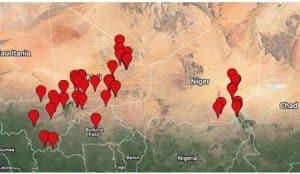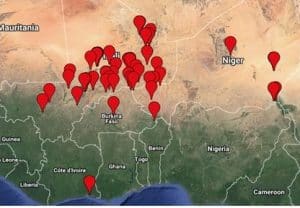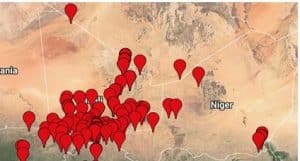African Union Warns IS Foreign Fighters Headed to Africa
December 17, 2017 in Africa, al-Qaeda, IS, Islamic StateReports have emerged that up to 6,000 Africans who fought for the so-called Islamic State (IS) are making their way back to Africa after the group was forced out of territory previously held in Syria and Iraq. The threat posed by IS militants was raised on 11 December 2017 during a meeting on counter-terrorism organized by the African Union (AU) and Algeria. The AU’s top security official called on regional countries to prepare. The report comes as the G5 Sahel is launching operations in the West African region amidst an increase in terrorist activity in the past year.
Smaïl Chergui, the AU’s commissioner for peace and security, told the meeting “there are reports of 6,000 African fighters among the 30,000 foreign elements who joined this terrorist group in the Middle East.” He warned that African countries will need to work closely with one another to share intelligence in order to counter returning militants.
After IS seized vast swathes of Iraq and Syria in 2014, tens of thousands of foreigners joined the terrorist group. However, in the last year, IS has suffered a string of losses to both its territory and military capabilities. Earlier this month, Iraq declared that the country was had been liberated from IS’ control. In Syria, the terrorist group remains under pressure. The squeeze on IS in Iraq and Syria has sparked concerns that its remaining foreign fighters will return home to spread their ideology or conduct extremist actions.
Africa’s Fragile Security Situation
Africa’s security situation remains fragile as a number of countries are battling insurgencies led by major terrorist groups with links to al-Qaeda and IS. Continued insecurity in Libya and Mali, along with insurgencies in Somalia and Nigeria, have transformed areas of the continent into breeding grounds for jihadi activity – resulting in regional instability. Fighters with weaponry are able to move with relative ease through the porous borders. These regional conflicts have also spilled across borders, and have begun to impact stable nations.
In Nigeria, Boko Haram’s nine-year insurgency has continued, despite the Nigerian government’s announcements on numerous occasions that the terrorist group has been defeated. Although the number of attacks in the northeastern region of the country has significantly declined in the last year, and Boko Haram no longer controls major areas, suicide bombings continue to target mosques, markets and other soft targets. The Far North region of Cameroon and the southern Diffa region of Niger have been impacted by Boko Haram violence. In Somalia, al-Shabaab has remained active, and in October the group launched their deadliest attack – a truck bombing in the capital Mogadishu that killed over 500 people. The United States has carried out dozens of airstrikes targeting senior al-Shabaab commanders this year, however the central government in Mogadishu has minimal control outside the capital. Al-Shabaab has continued to launch attacks near the border regions with Kenya.
In West Africa, the continued situation in Mali has increasingly impacted security across the region. Fighting has spilled as terror groups launch attacks in Ivory Coast, Burkina Faso, and Niger. In 2015, at least 81 incidents of terrorism were reported in Burkina Faso, Mali, and Niger, with most incidents occurring in Mali. In 2016, this figure decreased slightly to 70 incidents, yet regional terrorist groups proved their operational capabilities by launching a major attack in Grand Bassam Ivory Coast in March of that year. In 2017, the number of terrorist incidents has nearly doubled from 2016, with at least 132 attacks reported as of 15 December. Furthermore, the northern Sahel region in Burkina Faso has seen a sharp rise in extremist activity this year, as terrorist groups operating in the area increasingly target local communities.
2015 – 81 Terrorist Incidents reported; most activity occurring in Mali
2016 – 70 terrorist incidents reported. While activity slightly declined, groups are becoming bolder, launching major attacks in countries not previously threatened by terrorism, like Ivory Coast
2017 – 132 incidents reported as of 15 December, with a major expansion of reported incidents in the southern region of Mali, northern area of Burkina Faso, and western Niger.
The African continent is now under increased threat from a battle between IS and al-Qaeda, as both terror groups seek to gain influence in the region. This battle has already begun; IS aims to find new territory after suffering major losses in Iraq and Syria, and al-Qaeda aims to secure its future on the African continent by expanding its operations into countries previously unaffected by terror, and forming alliances in the sub-Saharan region.
IS influence on the African continent has increased in recent years – Boko Haram has split, with one faction continuing under the al-Qaeda banner and another pledging allegiance to IS. Similarly in Somalia, a small group of IS fighters have emerged and launched attacks in the Puntland region, though officials have indicated that their influence remains minimal. Al-Qaeda has also sought to expand their influence, and have used Mali’s continued insecurity to their advantage. New groups have emerged along the southern Malian border with Burkina Faso and Niger. These groups have proven to be deadly as they have launched attacks on the local communities, kidnapping and killing locals as they attempt to spread their ideology.
While the G5 Sahel operation is a sign that West African leaders are aware of the threat posed by terrorist groups operating in the region, its impact remains to be seen as funding issues have impacted the operation.
Islamic State Calls for More Attacks During Ramadan
June 20, 2017 in IS, ISIS, Islamic StateAn audio message released this week purporting to come from the spokesman of the so-called Islamic State (IS) group called on followers to launch attacks in the United States, Europe, Russia, Australia, Iraq, Syria, Iran and the Philippines during the Islamic holy month of Ramadan, which began late last month.
The audio clip was distributed on Monday 12 June on IS’ channel on Telegram, which is an encrypted messaging application. The audio was attributed to the militant group’s official spokesman, Abi al-Hassan al-Muhajer. While the authenticity of the recording has not yet been independently verified, the voice was the same as a previous audio message purported to be from the spokesman.
Islamic State Group “Lost Quarter of Territory” in 2016
February 1, 2017 in IS, ISIS, Islamic StateAccording to new analysis, the so-called Islamic State (IS) group lost almost a quarter of its territory in 2016.
Security and defense analysts IHS Markit have reported that last year, the terrorist group gave up almost 18,000 sq km (6,900 sq miles), with its territory effectively reducing to some 60,400 sq km, just less than the size of the US state of Florida. According to IHS Markit, the 23% reduction in IS-held territory in 2016 followed on from a 14% loss in 2015.
IHS Market predicted the recapture of Mosul by Iraqi government forces by the middle of the year, nothing that the stronghold of Raqqa would be more difficult to recapture. What is also troubling is that IS retook the city of Palmyra in December 2016.
The report also highlighted what it said was a major theological dispute within IS, between those following mainstream doctrine and those taking a more radical interpretation, noting that this could raise the risk of defections or even cause an internal break-up.
IS May Be Regrouping in Libya After Loss of Sirte Stronghold
December 29, 2016 in IS, Libya
During a seven-month campaign to seize control of Sirte, the only Islamic State (IS) stronghold in Libya, IS has lost senior figures in what is now an unsuccessful battle to defend its coastal stronghold. However there have been growing signs that the militant group has already moved on to try to fight back through sleeper cells and desert brigades.
For months now, Libyan officials have been warning that hundreds of IS militants may have escaped before the battle for Sirte was launched in May or during its early stages. This has prompted concerns of a counter-attack or insurgency campaign that could allow the militants to show that they are still in business despite losing control of Sirte, which comes as the group is also under intense military pressure in its core territory of Iraq and Syria.
According to some experts, some cells have already been active and it is now thought that the militant group is behind at least two dozen attacks or attempted attacks that have occurred to the south and west of Sirte since August.
Before the launch in May of the operation to gain back Sirte, IS was thought to have several thousand fighters stationed in Sirte. It should be noted that estimates of the exact number have varied widely. According to residents of Sirte and security officials in Misrata, the city that led the campaign to retake the militant group’s stronghold, both leadership and rank and file had a heavy presence of foreigners, adding that the group drew on recruits from northern and sub-Saharan Africa. It is believed that much of that force has been killed in the past seven months as IS was also targeted by nearly 500 US air strikes since 1 August. Local officials have reported that amongst those killed were a number of high-level Libyan figures, including preacher and commander Hassan al-Karami and senior official Abu Walid al-Ferjani. According to messages of mourning that were posted on social media accounts close the militant group, a number of foreign commanders were also killed, however it currently remains unclear how far up the hierarchy they were or how important to the group’s future operations. While Misrata officials have refused to disclose on reports of IS militants being killed after capture, fighters and commanders have indicated that they took few, if any, prisoners. Ibrahim Baitulmal, head of Misrata’s military council, has disclosed that an estimated 1,700 jihadist’s bodies had been recovered during the campaign, noting however that the number killed is much higher as militants retrieved some of their own dead. He noted that those killed in the final days of the battle for Sirte included Abu Habib Jazrawi, a Saudi who is thought to have taken the name Abdul Qadr al-Najdi before being named as IS’ leader in Libya in March. While IS has not announced his death, regional media reported that Najdi was replaced in September by a Tunisian, Jalaludin Al-Tunsi, who was possibly appointed to carry on the fight outside Sirte.
What is clear is that IS has made no secret of its plans to continue the fight. In August, the new leader of IS’ Libyan branch, Abu Musab al-Farouq, disclosed that high-level figures who had escaped from Sirte were helping it regroup not far away. Months later in late October, the head of the west Libyan branch, Abu Hudhayfah al-Muhajir, acknowledged that the group had been suffering, stating however that it would continue its campaign for “conquest and empowerment” and that it was still attracting a steady flow of foreign fighters.
After a Series of Setbacks, IS Launches String of Deadly Attacks in Syria
September 15, 2016 in Iraq, IS, ISIS, Islamic State, SyriaIn recent weeks, the so-called Islamic State (IS) group has suffered a series of setbacks in Syria, including the loss of access to the Syria-Turkey border and the killing of a number of top leaders. Analysts however warn that the terrorist group remains a potent force – a fact that has been demonstrated by a series of deadly attacks.
The growing pressure on IS, which includes Turkey’s decision to launch an operation against it in northern Syria, has seen the militant group lose ground at an unprecedented pace. IS however continues to maintain the capacity to obtain weapons, attract recruits and deploy fighters to carry out devastating attacks abroad.
On 4 September, the Turkish operation reclaimed the last stretch of the Syria-Turkey border from IS, effectively sealing off its self-styled “caliphate” in Syria and neighbouring Iraq and forcing the group to rely on smuggling networks instead. For IS, this was just the latest setback as the group is now under attack from Syrian and Iraqi troops, as well as Kurdish fighters, Syrian rebels, Turkish Forces, Russian warplanes and a US-led coalition. Experts believe that IS now controls just 20 percent of Iraq and 35 percent of Syria. At the height of its expansion, after it seized Syria’s Palmyra in May 2015, IS controlled around 240,000 square kilometres (more than 92,000 square miles) in both countries – an area roughly the size of Britain. Today however experts indicate that this number has fallen by more than a third to around 150,000 square kilometres, adding that the population it now controls has also declined from some eight million people in mid-2015 to 4.5 million people today. In another major blow to the group’s mobility, in August, IS lost Jazirat al-Khaldiyeh, an area in Iraq’s western Anbar province that was a key crossroads. Meanwhile in Libya, IS is on the verge of losing its stronghold of Sirte. Along with the territorial losses, IS has been affected by a number of high-profile assassinations of its key leaders, which include senior commander Omar al-Shishani and spokesman and top strategist Abu Mohamed al-Adnani.
While these setbacks paint a picture that IS is on the decline, analysts are increasingly warning that the group is far from finished, noting that its focus may simply be shifting from territorial expansion to consolidation of population centres, such as Syria’s Raqa and Iraq’s Mosul, and to launching new attacks against civilians in the region and the West. IS has proven capable of adapting to the changing territory, and it likely that it will do the same this time around. The loss of the border with Turkey will hamper the group’s abilities to import new weapons and recruits, as well as to export resources such as oil. However this challenge is hardly a new one as pressure from Kurdish forces coupled with a Turkish crackdown on the border had already forced IS to mainly rely on smuggling networks. In regards to attaining weapons, IS has always relied to some degree on purchasing from corrupt individuals among its enemies, or capturing arms from defeated opponents.




